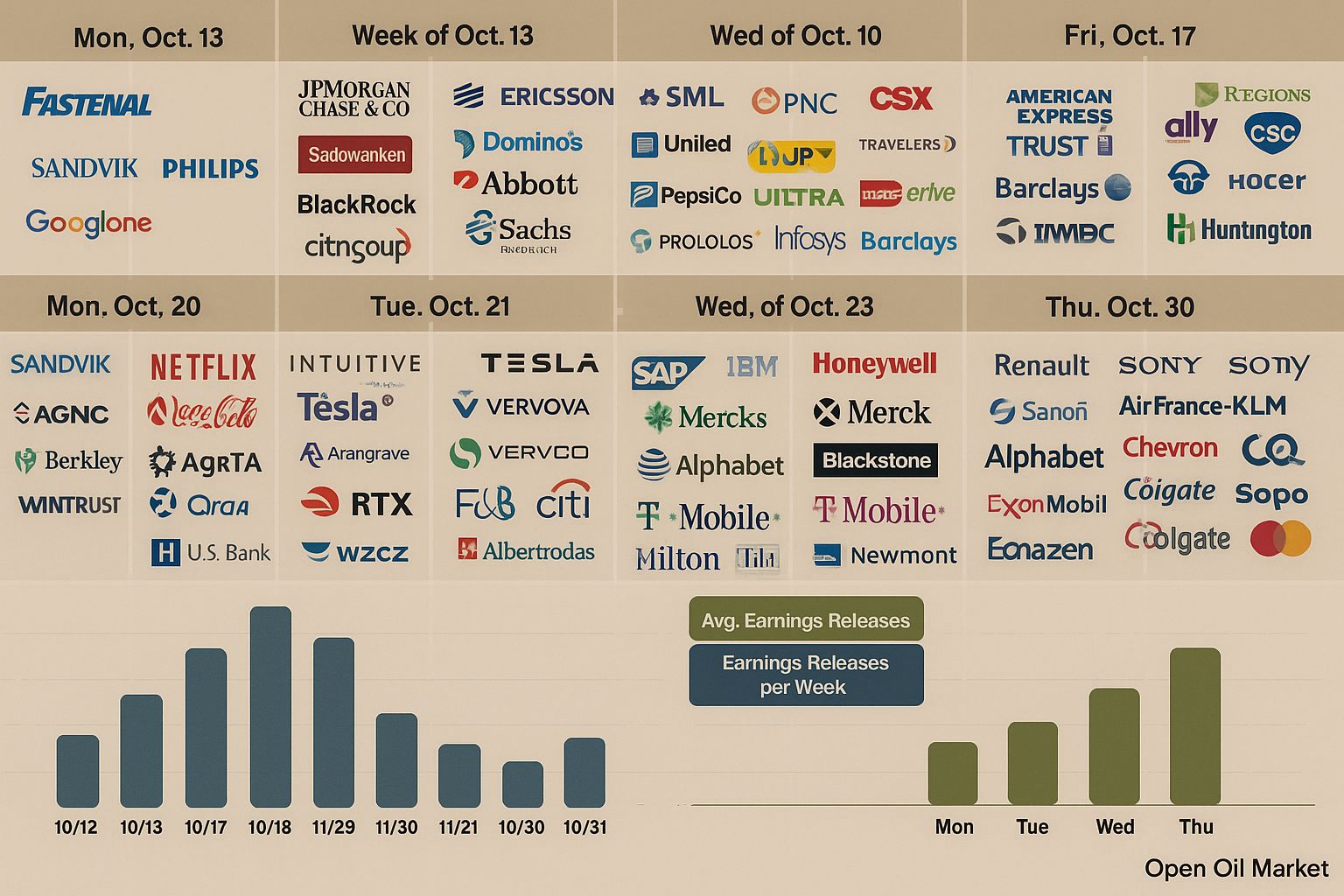
Analytical Review of Key Economic Events and Corporate Reports for October 2025: Results from S&P 500, Euro Stoxx 50, Nikkei 225, and MOEX, Central Bank Decisions, and Forecasts for CIS Investors.
October 2025 marked the start of a new earnings season, attracting increased attention from CIS investors. During this period, the largest publicly traded companies in the United States (S&P 500), Europe (Euro Stoxx 50), Asia (Nikkei 225), and Russia (MOEX) published their financial reports for the third quarter, alongside significant macroeconomic events. Against the backdrop of expectations from corporate reports and profit forecasts, global markets reacted to key economic events, ranging from inflation data releases to central bank meetings. Below is a monthly calendar of events for October 2025, presented week by week, containing a daily overview of important corporate disclosures and macroeconomic indicators.
Week 1 (October 1–3, 2025): A Calm Beginning and Important Macroeconomic Statistics
The first week of October began relatively calmly in terms of corporate news, as the earnings season was just gathering momentum. However, significant signals were already emerging on the macroeconomic front that could set the tone for the markets. Investors focused on global economic data, anticipating how these would impact sentiment before the rush of S&P 500 earnings reports.
- Wednesday, October 1: OPEC held a meeting to discuss oil production quotas—an important event for oil and gas companies and energy markets. In the Eurozone, preliminary consumer inflation estimates (CPI Flash) were released, indicating price dynamics in the region, while in the U.S., the ISM Manufacturing PMI was published. These economic events set an initial tone for investors assessing the state of the global macroeconomy.
- Thursday, October 2: Attention turned to U.S. labor market data—weekly unemployment claims revealed the state of employment ahead of the official labor market report. There were no substantial corporate reports from S&P 500 or Euro Stoxx 50 companies that day, so markets primarily reacted to macroeconomic data and expectations for forthcoming events.
- Friday, October 3: The key event of the day was the U.S. Non-Farm Payrolls report for September. The data showed trends in job creation and the unemployment rate, which directly impacts forecasts for the Fed's monetary policy. Although there were no major corporate reports this week, a strong or weak labor market report could adjust investor expectations and company profit forecasts against macroeconomic trends.
Week 2 (October 6–10, 2025): Initial Reports and Signals from Central Banks
The second week of the month saw the corporate earnings season gradually pick up pace. The first reports from S&P 500 companies emerged, and CIS investors began to pay attention to Asian company results and preliminary outcomes from European businesses. Concurrently, significant economic events unfolded, including data publications and speeches from central bank representatives, which helped adjust macroeconomic expectations.
- Monday, October 6: The week opened without major corporate releases, yet macroeconomic statistics set the tone. In the Eurozone, data on retail sales reflecting consumer demand was published, while the UK released a PMI index for the construction sector. Investors scrutinized these indicators, evaluating economic activity ahead of the week’s major events.
- Tuesday, October 7: External trade data became the focus: the U.S. and Canada released August trade balance figures, providing insights into the import-export dynamics in North America. Meanwhile, European markets analyzed data on manufacturing orders from Germany. Major companies were preparing for their earnings releases, so the economic events dominated market movements.
- Wednesday, October 8: The key event of the day was the release of the FOMC Minutes from the September Fed meeting, with investors globally seeking signals regarding the direction of interest rates. Additionally, the Reserve Bank of New Zealand announced its rate decision—the first among central banks this month—highlighting a global trend towards revising monetary policy. Markets reacted cautiously, waiting for the impending start of the S&P 500 earnings season.
- Thursday, October 9: Investors received the first significant corporate results of the season. American food giant PepsiCo published its third-quarter report, showing resilient revenue growth that exceeded some analysts’ profit forecasts. In Asia, Japanese Fast Retailing (owner of Uniqlo) concluded its fiscal year: the company's report revealed double-digit profit growth, setting a positive tone for the retail sector in the region. Russian Sberbank also reported selective results under RAS for the first nine months of 2025, noting a ~6% year-on-year increase in net profit—an important consideration for investors on MOEX. Besides corporate reports, Federal Reserve Chairman Jerome Powell’s speech clarified that the regulator maintains a balanced approach to rate changes, taking into account mixed economic signals.
- Friday, October 10: As the week concluded, markets focused on consumer sentiment in the U.S.—the preliminary consumer confidence index from the University of Michigan was published. This indicated households' inflation expectations and economic confidence levels, which are crucial for macroeconomic forecasts and, indirectly, for consumer services companies. No major corporate reports were released that day, but investors prepared for the main wave of earnings reports starting next week.
Week 3 (October 13–17, 2025): The Start of Mass Reporting and Inflation Data
The third week of October proved pivotal: the mass publication of financial results from the largest corporations began—the wave of S&P 500 reports, particularly from U.S. banks and the industrial sector, which constitute a significant portion of the index's capitalization. Concurrently, an array of inflation indicators was released across various countries, enabling investors to adjust expectations for interest rates. Economic events and corporate earnings intertwined, directing global markets.
- Monday, October 13: The earnings season officially kicked off in the U.S.: several major Wall Street banks, such as JPMorgan Chase and Citigroup, published third-quarter results. Banking reports indicated a rise in interest income due to prior Fed rate hikes, surpassing some analysts' expectations. In Europe, French luxury conglomerate LVMH reported sales for the first nine months: despite a challenging macroeconomic environment, LVMH’s revenue continued to grow, confirming strong demand for luxury goods. The start of the week was also marked by a major international event—the annual meetings of the IMF and World Bank commenced in Marrakech, where financial leaders discussed the global economic outlook. For CIS investors, this signified the emergence of initial benchmarks for both corporate profits and global economic sentiment.
- Tuesday, October 14: Macroeconomic indicators from the UK and Eurozone took center stage. In the UK, new labor market data emerged: the unemployment rate and average wage growth over the last three months, influencing the Bank of England's policy. Simultaneously, the German ZEW business expectations index reflected ongoing uncertainty. On the corporate front, the string of banking reports in the U.S. continued (for instance, Bank of America and Wells Fargo reported profits reflecting strong results from consumer lending), while multinational healthcare company Johnson & Johnson from the S&P 500 delivered strong quarterly results, raising its annual profit forecast.
- Wednesday, October 15: The day’s key event was the release of U.S. inflation data for September: both the core consumer price index (Core CPI) and the overall CPI demonstrated a slowing annual price increase. This bolstered expectations that the Fed would pause interest rate hikes, which is favorable for the stock market. The technology sector in the S&P 500 reacted positively, as the prospect of a more lenient monetary policy supports valuations of high-tech companies. Meanwhile, in Europe, high-tech giant ASML (part of the Euro Stoxx 50) reported revenue growth for the third quarter, driven by high demand for semiconductor equipment. On a global scale, the IMF's annual meetings continued, discussing risks and forecasts for the world economy, keeping investors alert.
- Thursday, October 16: The news flow continued unabated. The U.S. published the Producer Price Index (PPI) and retail sales data—both indicators that drew attention as measures of consumer activity and inflationary pressure. On this day, strong reports from Asian and European companies were released: Taiwanese TSMC, a leading chip producer, announced quarterly profit growth, lifting the Asian tech sector. Swiss food giant Nestlé reported sales for the first nine months of 2025: while the overall volume saw moderate growth, the firm confirmed its year's forecast, positively received by the market. In the Russian market, there were no significant corporate updates, and investors in Moscow primarily monitored global trends and commodity prices.
- Friday, October 17: As the week came to a close, Eurostat published final inflation figures for the Eurozone for September—the rate of price growth confirmed a moderately high level, supporting expectations of ongoing hawkish rhetoric from the ECB. In Washington, the annual meetings of the IMF and World Bank concluded, culminating in warnings about slowing global growth and recommendations for fiscal policies. The corporate season continued: American Procter & Gamble (S&P 500) reported increased sales in household goods, managing to pass on cost increases to consumers. This news instilled confidence that major companies can protect margins even in rising inflation conditions, which is important for investors anticipating stable corporate profits.
Week 4 (October 20–24, 2025): Peak Reporting and Regulatory Decisions
The fourth week of October became the peak of the corporate earnings season—investors received results from major corporations almost every day. Concurrently, central banks stepped into the spotlight: several regulators in key global economies held meetings, with decisions capable of significantly impacting financial market sentiment. For investors from the CIS countries, this week was particularly informative: on one hand, S&P 500 reports provided guidance on global corporate earnings; on the other hand, macroeconomic signals helped readjust strategies.
- Monday, October 20: The week commenced with a busy corporate agenda. Before the U.S. markets opened, several industrial and consumer giants released reports: for instance, 3M Company provided profit data, while Coca-Cola published quarterly revenue, indicating sustained demand for beverages even amid inflation. In China, the People's Bank of China announced its LPR rate decision—it remained unchanged, signaling efforts to support economic growth. In the UK property market, the Rightmove housing price index showed a slight decline, reflecting cooling demand for real estate.
- Tuesday, October 21: On this day, investors focused on the tech sector. After the U.S. market closed the previous day, Netflix released its earnings report: the largest streaming service in the S&P 500 reported confident growth in subscribers and profits, exceeding expectations. This laid a positive foundation for the entire technology segment. Meanwhile, the European agenda was relatively calm—no significant macroeconomic publications or Euro Stoxx 50 reports occurred, allowing markets to digest the influx of corporate news from America.
- Wednesday, October 22: This day was marked by important indicators and reports. In the UK, inflation (CPI) data for September revealed a slight slowdown in price growth, indicating that previous Bank of England rate hikes were beginning to impact the economy. On the corporate front, several global companies reported profits on Wednesday evening. In the U.S., automaker Tesla published results after market close: while revenue growth continued due to high electric vehicle deliveries, investors closely examined the company’s profitability forecasts amidst fluctuations in raw material prices. In Europe, German banking leader Deutsche Bank unveiled quarterly results, highlighting unexpected growth in investment banking revenues; this supported financial sector stocks on the Frankfurt and London exchanges.
- Thursday, October 23: Markets experienced one of the most news-heavy days in October. In the morning, investors received Germany’s business climate data (Ifo index), which indicated improved business sentiment, instilling hope for stabilization in the Eurozone’s largest economy. Corporate earnings continued: American chipmaker Intel reported quarterly results, noting margin improvement due to increased demand for server processors, surpassing analysts' profit forecasts. Additionally, automotive giant Ford reported results after market close, indicating a profit decline due to expenses related to the transition to electric vehicles—a reminder of the risks associated with industry transformation.
- Friday, October 24: As the intense week concluded, investors received a block of global macroeconomic statistics. In the morning, UK retail sales data revealed cautious consumer behavior amid high prices. Attention then shifted to global business activity indices: preliminary (flash) PMI values for the manufacturing and services sectors in the Eurozone, UK, and U.S. were released. These timely indicators signaled a slowdown in Europe’s industry alongside sustained growth in the U.S. services sector, highlighting the uneven recovery of the global economy. Additionally, the Central Bank of Russia held a meeting, where it decided to cut the key rate by 100 basis points, to 16.0% per annum—a signal of a monetary policy easing that is significant for the domestic credit market. The corporate front also provided important news: American Procter & Gamble concluded the week with a strong sales report, while large investment funds on Wall Street (such as Blackstone) noted growth in assets under management. Thus, the week closed on a positive note—investors received confirmation that many companies are successfully adapting to economic conditions, and central banks are ready to support the economy at the first signs of easing inflation.
Week 5 (October 27–31, 2025): Technological Crescendo and Final Data of the Month
The last week of October brought the culmination of the reporting season and key decisions from several central banks, serving as a concluding note for the month. CIS investors closely monitored the outcomes of the meetings of the U.S. Federal Reserve, ECB, and Bank of Japan, as their policies influence global liquidity and risk appetite in emerging markets. The financial results of leading technology firms and oil and gas giants set the tone as the year approached its final stretch.
- Monday, October 27: At the start of the week, markets received a mixed set of signals. U.S. data on durable goods orders reflected stable corporate investment in September—a positive sign for the industrial sector. Asian markets reacted with growth after weekend regulatory hints in China indicated readiness to support liquidity by easing banks’ reserve requirements. Few first-tier corporate reports were released that day, allowing investors to catch their breath after the tumultuous prior week.
- Tuesday, October 28: Ahead of a string of central bank announcements, market participants focused on assessing consumer sentiment. In the U.S., the Conference Board consumer confidence index showed a slight decline, signaling households’ cautiousness amidst high interest rates. Nevertheless, in the evening, investors awaited a wave of important news: after market close in New York, Microsoft released its earnings report. The tech giant reported revenue growth due to sustained demand for cloud services, exceeding profit forecasts. This provided a positive momentum for the entire IT sector. Anticipation of similar reports from other S&P 500 'stars' bolstered market growth.
- Wednesday, October 29: One of the key days of the month. The U.S. Federal Reserve announced its interest rate decision: the regulator kept the rate unchanged, confirming a wait-and-see position amid declining inflation. Simultaneously, the Bank of Canada also maintained its rate stability, indicating similarities in approaches among major central banks. These decisions bolstered investor optimism, expecting stabilization of financing conditions. Corporate news was equally significant: Meta (Facebook) presented strong financial results for Q3, including growth in advertising revenue, reflecting a recovery in the global advertising market. In Europe, Deutsche Bank’s report attracted attention—the details confirmed the previously noted trend towards improving metrics, and the bank's stock continued to rise. Meanwhile, in Japan, a two-day Bank of Japan meeting began, where investors anticipated possible changes to the yield control policy.
- Thursday, October 30: The final crescendo of the earnings season for American blue-chips. After market close in the U.S., two titans of the technology sector—Apple and Amazon—released their results. Apple reported high sales of new iPhone models and growth in service revenue, maintaining margins at expected levels, while Amazon surprised investors with a sharp rise in profitability from its cloud business, AWS, exceeding analysts' forecasts. These S&P 500 reports strengthened market faith in the resilience of the technology sector. Equally important were events in Europe and Asia: the European Central Bank decided at its meeting to keep the base rate unchanged, pointing to signs of declining inflation in the Eurozone. The Bank of Japan, in turn, maintained an ultra-loose policy but signaled potential corrections in yield control—this triggered fluctuations in the yen’s exchange rate and volatility on the Tokyo stock exchange. Among European companies, oil and gas company Shell reported a leap in quarterly profits due to high oil prices and expense optimization—news positively received by energy sector investors.
- Friday, October 31: The last day of the month summarized key macroeconomic and corporate results. In the Eurozone, preliminary estimates of inflation for October were released—both the core and overall CPI showed further slowing to minimal levels in the past year and a half. This strengthened the confidence that the ECB would refrain from new rate hikes, positively affecting stocks and bonds in the European market. In the U.S., a key inflation indicator for the Fed—the core Personal Consumption Expenditures price index (Core PCE)—also showed a slowdown in growth, while the Employment Cost Index (ECI) reflected a moderate increase in wage costs. These data confirmed that inflationary pressure is receding. The corporate sector wrapped up the month with reports from major American oil companies: ExxonMobil and Chevron reported profit declines compared to last year due to lower oil prices; however, both companies announced retention of generous dividends. Meanwhile, on the Russian market, investors analyzed monthly inflation data for October, awaiting further steps from the Bank of Russia. Thus, October 2025 concluded on a positive note: global economic trends point to easing inflation, and a significant number of companies managed to meet or exceed profit forecasts, strengthening investor confidence in market stability.
Conclusion: Lessons from October and Guidance for CIS Investors
October 2025 proved to be a rich period, combining the "harvest season" of corporate reports and crucial economic events from the global macroeconomy. For investors from CIS countries, a key takeaway for the month was the confirmation of the relative resilience of global businesses in the face of high rates and inflation: many companies demonstrated the capacity to adapt and maintain profitability, meeting analysts' profit expectations. Concurrently, central banks of leading economies signaled readiness to pause policy tightening as inflation slows—this factor supports demand for risk assets, which is essential for Russian markets as well.
In the remaining weeks of the year, CIS investors should consider several points. First, company earnings for the third quarter laid the groundwork for forecasts for the final quarter: special attention should be given to management comments regarding sales and margin prospects in a changing macroeconomic environment. Second, global macroeconomic events of October—from Fed and ECB decisions to inflation data—reduce uncertainty regarding future interest rate movements. This aids in forming a clearer asset class strategy, particularly regarding bonds and currencies in emerging markets. Finally, CIS investors should continue to diversify portfolios, considering global trends: the combination of "macro plus corporate reports" remains decisive for sentiments on the exchanges. A well-thought-out analysis of the signals from October and their incorporation into investment decisions will help face the closing months of the year well-prepared and with a clear understanding of market benchmarks.




